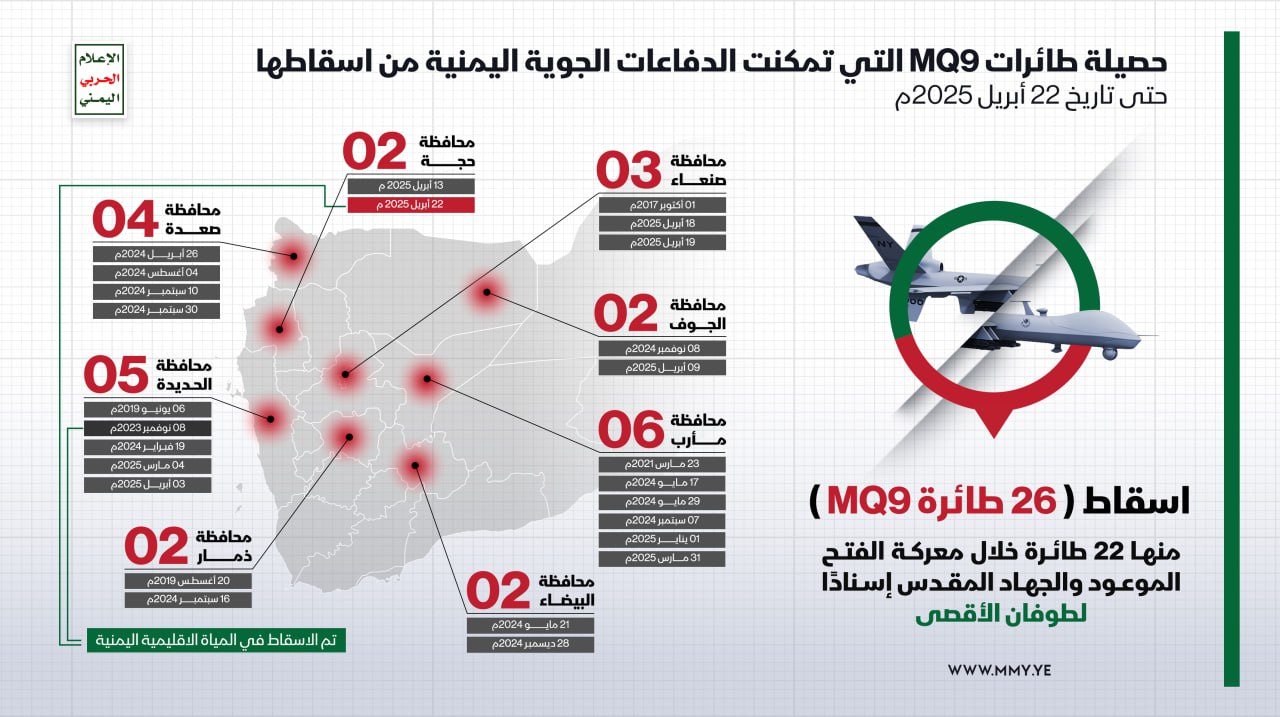Washington continues to mire itself deeper into the Yemeni quagmire, despite the American consensus on the utter failure to achieve its declared objectives. Since mid-March, U.S. warplanes have intensified their aggressive raids across several provinces. Yet, their targets have largely been residential areas, the remnants of a port, a cancer hospital, Bedouin tents, markets, and roads, resulting in hundreds of martyrs and wounded civilians. Meanwhile, Yemeni missiles and drones, as confirmed by settlers' sirens and Zionist surveillance cameras, remain intact and continue to perform their missions with remarkable effectiveness.
The United States suffers humiliating defeats on multiple fronts. In the Yemeni airspace, Yemeni air defenses have demonstrated tangible progress in capabilities and operational effectiveness. Over the past week alone, they managed to shoot down three armed MQ-9 Reaper drones over the provinces of Sana'a and Hodeidah, bringing the number of American drones downed this month to seven, and the total number of drones shot down since the start of U.S. support operations to 22. The financial losses now exceed $200 million—the highest cost the Pentagon has incurred in its campaign against Yemen. It is worth noting that each MQ-9 Reaper drone, capable of flying at altitudes above 12,000 meters, is valued at around $30 million, making their downing a significant military achievement.
[caption id="attachment_792049" align="aligncenter" width="1280"]
 Infographic: The tally of MQ-9 drones downed by Yemeni air defenses (as of April 22, 2025).[/caption]
Infographic: The tally of MQ-9 drones downed by Yemeni air defenses (as of April 22, 2025).[/caption]
The most striking development is the qualitative leap in Yemen’s air defense capabilities. According to consistent reports from Fox News, The War Zone, CNN, and the Associated Press, Yemeni forces successfully downed at least seven advanced MQ-9 Reaper drones within a few weeks, with each drone valued at tens of millions of dollars, bringing total losses to over $200 million.
The resounding shock to Washington stems from Yemen’s evolved ability to neutralize its most sophisticated unmanned aircraft. Within less than six weeks, Yemeni air defenses have successfully downed seven U.S. Reaper drones, as reported by the Associated Press, citing military officials. These staggering financial losses, exceeding $200 million, represent the costliest blow to the Pentagon in its futile campaign against Yemen. Considering the cost and high-altitude capabilities of the Reapers, this Yemeni achievement delivers a resounding slap to American arrogance and its purported technological superiority.

The loss of these drones, heavily relied upon by Washington for surveillance and reconnaissance operations, constitutes a significant strategic setback for the United States, hampering its ability to transition to the "second phase" of its operation, which aimed at achieving air superiority and targeting Ansar Allah leaders.
American officials have admitted that the "continued loss of drones has made it difficult for the United States to assess the degradation of Houthi weapons stockpiles accurately," acknowledging that Yemeni forces' performance in targeting these drones is steadily improving.
Neutralizing U.S. Naval Power
In a major development that signals a radical shift in naval power dynamics, Yemeni armed forces are tightening their grip over the Red Sea’s territorial waters, expanding their operations beyond targeting Israeli commercial vessels to directly engaging U.S. naval assets. This escalation, rooted in Yemen’s unwavering support for Palestine and Gaza, casts a grim shadow over Washington’s ability to project influence and manage military operations in this vital region.
Yemeni military operations have severely hampered U.S. strategic plans based on rapid deployment across extended seas. This strategic advantage was lost with Yemen’s closure of the Bab al-Mandeb Strait—the main artery for U.S. military supplies. A report from the Washington Institute for Near East Policy noted that "the growing threats to American military supplies due to Houthi attacks in the Red Sea significantly hinder Washington’s ability to deploy forces and manage operations effectively." This assessment reflects the growing confusion and concern within the U.S. military establishment over Yemen’s evolving capabilities.
Moreover, Yemen continues to neutralize U.S. naval assets, including aircraft carriers. Just days ago, American officials told Al Jazeera that the USS Truman would soon be withdrawn, confirming earlier assertions by the President of the Supreme Political Council that Truman was rendered inoperable by Yemeni strikes during its first encounter. President Mahdi al-Mashat commented to the Yemeni News Agency (SABA) that "the Trump administration has engaged in deception and lies since the first day of its aggression against Yemen, including the false media narrative suggesting that Truman was not disabled by heroic Yemeni forces, which stripped it of operational readiness and initiative early in its involvement." Al-Mashat challenged international media, including American outlets, to demand that the criminal Trump administration publish Truman’s operational logs and camera footage from March 20 to 23, 2025.
Further corroborating Sana’a’s credibility, the Yemeni army previously succeeded in disabling three U.S. aircraft carriers during the initial escalation over Gaza: the Eisenhower, Lincoln, and Roosevelt. Washington’s need to deploy new carriers—despite mounting tensions with China—underscores the depth of the American crisis in the Red Sea.
Chinese platform "Bai Jiahao" also confirmed that the USS Carl Vinson suffered significant damage, forcing it to retreat 800 kilometers—a major blow to the U.S. Navy’s formidable image.
Adding to the drone losses are the colossal operational costs of U.S. military campaigns. The daily operational cost of a single aircraft carrier ranges between $6 million and $8 million, potentially rising to $10 million during combat operations, not to mention millions more for maintenance, training, and operations. The use of expensive interceptor missiles, such as the THAAD missile, each costing between $11 million and $15 million, with a single THAAD battery costing between $800 million and $1.2 billion, further underscores that the U.S. is slipping into an extremely costly "war of attrition" in Yemen. While Washington might sustain such expenses for months, the mounting costs and losses raise serious questions about the viability of this campaign.
Structural Challenges and Delays in U.S. Military Development
An Italian defense magazine report sheds light on the immense challenges facing the U.S. Navy in integrating new counter-drone systems onto its advanced destroyers, pointing to a complex technical and military dilemma hampering its ability to keep pace with the rapidly escalating threats from Yemeni forces. Furthermore, a report by the U.S. Naval Institute highlights the significant obstacles delaying the Navy’s efforts to develop and deploy an effective fleet of unmanned surface vessels, warning that reliance on unmanned ships remains sluggish and fraught with structural and tactical challenges impeding this vital strategic transformation.

These realities indicate that the brutal American aggression against Yemen has failed to achieve its objectives of deterring or weakening the Yemeni forces. On the contrary, these strikes have only strengthened Yemenis’ resolve to continue supporting Palestine and resisting American influence in the region.
Admissions by American media and military officials regarding the mounting challenges and devastating losses in the Red Sea are a testament to America's strategic decline and the shifting balance of naval power in the region. Yemen, with its modest resources but unwavering determination, is redefining the rules of engagement and forcing the world’s strongest navy to reconsider its strategies in a region increasingly resistant to absolute American domination.
This continuous American failure in Yemen—and its escalating material and human losses—will have profound repercussions within the United States. Questions about the utility of this senseless war will grow louder, and pressure on the American administration to halt this bleeding of resources will intensify. More critically, this military and political failure undermines the United States’ standing as a global power before its international rivals, who are closely monitoring this American retreat in the face of legendary Yemeni resilience.
Through its legendary steadfastness, immense sacrifices, and remarkable military advancements, Yemen has delivered the United States a harsh lesson in the art of warfare and the will of the people. This aggression will only enhance the pride, dignity, and determination of the Yemeni people to continue supporting their main cause. With Allah's help, Yemen will remain proud and unbreakable, a living testimony to the collapse of American illusions of power and its waning influence in the region.










